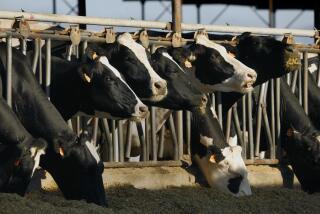Canada May Have New Mad Cow Case
WASHINGTON â One day after the United States announced it would resume importing Canadian beef early next year, Canada said today that inspectors may have discovered a new case of mad cow disease.
The Canadian Food Inspection Agency identified the animal as a 10-year-old dairy cow, but released few details. A preliminary test found signs of the disease a day earlier. Officials stressed that no part of the cow has entered the food supply for humans or animals.
The test results were deemed inconclusive. More analysis will be conducted over the next three to five days.
On Wednesday, the U.S. Department of Agriculture said that Canada had become the first country to meet new U.S. standards designed to reduce the risk of mad cow disease. A ban on imports of Canadian cattle would be eased beginning in March, U.S. officials said.
Ruling it a âminimal risk regionâ for the disease, the USDA said Canada had adopted effective procedures to detect the disease and prevent it from infecting herds.
âAfter conducting an extensive review, we are confident that imports of certain commodities from regions of minimal risk can occur with virtually no risk to human or animal health,â outgoing Agriculture Secretary Ann M. Veneman said.
The move could provide relief to Canadian cattle ranchers who have been shut out of U.S. markets for 19 months because of fears of mad cow disease. The first Canadian cow suffering from the disease was discovered in May 2003 and the first case of the disease in the U.S. herd â in a cow imported from Canada â was recorded last December.
âWe are extremely pleased that the U.S. administration has moved this rulemaking forward,â Stan Eby, president of the Canadian Cattlemenâs Assn., said in an interview from Alberta. âOur losses have been extremely serious. But the negative impact on our communities, especially in rural areas, canât even be measured. The vets have not had work, and everybody has pulled the belt in.â
Some in the industry criticized the USDA for not going far enough because the new rule, which is subject to congressional review, allows importation of cows less than 30 months old. Young animals are considered less vulnerable to the disease, formally known as bovine spongiform encephalopathy, which may be transferred to humans who consume contaminated meat and cause a brain-wasting ailment called Creutzfeldt-Jakob disease.
âScience and international trading guidelines say that the U.S. should permit imports of Canadian cattle regardless of age,â said J. Patrick Boyle, president of the American Meat Institute in Washington, the nationâs largest meat and poultry trade association. âIt is long past time for USDA to take a leadership role in operating within these international guidelines.â
To ban the import of older cattle is âarbitrary and capricious and not supported by science,â the meat institute said.
Amid complaints from Canadian ranchers that the ban was being left in place more to protect U.S. producers than American consumers, President Bush received an earful on the issue in November when he visited Canadian Prime Minister Paul Martin in Ottawa, and promised to expedite the process. Eby credited Bush for speeding things up.
Veneman conceded that the process was lengthy and noted that the rule itself was 500 pages long.
âWe took the time to get it right in order to uphold our commitment to protect human and animal health while allowing the resumption of safe and mutually beneficial trade,â Veneman said.
USDA officials said they expected Canada to ship approximately 2 million head of cattle through 20 entry points in the first year after the ban was lifted. The National Cattlemenâs Beef Assn. called on the USDA to ensure âan orderly processâ so the imports did ânot cause unnecessary disruption to the domestic cattle market.â
The U.S. and Canadian cattle industries have been integrated for centuries, with the first herds in Western Canada arriving from Texas in the 19th century. âWe depend on each other,â said Eby. âWe want to avoid any bumps in the road in the future.â
The Canadian imports will not greatly skewer the U.S. market â 32.5 million cattle were slaughtered in the United States this year â but the decision could help U.S. packers, who suffered from the loss of Canadian herds.
âWhen you ban the raw materials, itâs like outsourcing the jobs,â said Jim Maxey, vice president of the National Meat Assn., a trade group based in Oakland that represents meat packers and processors. The trade group is concerned because the new standard also allows Canada to export beef from older cattle, which will adversely affect U.S. processors.
More to Read
Sign up for Essential California
The most important California stories and recommendations in your inbox every morning.
You may occasionally receive promotional content from the Los Angeles Times.










